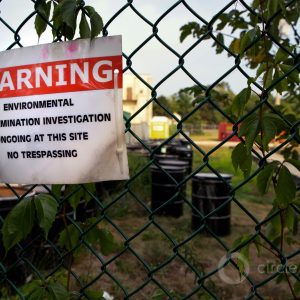Federal Water Tap, December 21: Supreme Court Rules In Favor of New Mexico in Pecos River Case
The Rundown
The Supreme Court hands New Mexico a victory over Texas in a case centered on reservoir evaporation. The Federal Reserve is now a member of a central bank group focused on the financial implications of climate change. The GAO uses demographic and housing data to analyze the location of lead service lines. A Colorado senator says that clean water for Native American tribes should be a federal priority. The Bureau of Reclamation reviews the guidelines for managing the Colorado River. The House passes a bill to provide low-interest loans for weather-disaster preparation. Florida gets EPA approval to run its own wetlands permitting program. The Department of Energy finalizes a rule that relaxes showerhead water-conservation standards. And lastly, the Office of Management and Budget begins reviewing a proposal to begin the rulemaking process for PFOA and PFOS in drinking water.
“Clean water is foundational to everything else.” — Sen. Michael Bennet (D-CO) speaking at an event on tribal water issues in the Colorado River basin. Bennet said that his priorities are four-fold: work with the Biden administration to secure funding for tribes for water; work on legislation to coordinate federal efforts on tribal clean water; make sure the Biden administration consults closely with tribal leaders; and work to introduce a resolution in the Senate underscoring the federal government’s trust responsibility for tribes. “It’s well past time that we move past from talking about these problems and take action,” he added.
By the Numbers
#1: Streamflow in the United States was the highest in the 90-year period of record keeping. The record was driven by a historically wet year in the Mississippi River and Great Lakes basins, where 10 states had record-high runoff years. (U.S. Geological Survey)
News Briefs
Fed Joins Green Banking Group
The Federal Reserve Board announced that it is joining the Network for Greening the Financial System, a central bank response to the financial implications of climate change.
The network aims to prepare for the financial risks of a warming planet and to marshal the capital for low-carbon investments.
In November, the Fed began including a section on climate change in its semiannual report on risks to the U.S. financial system.
Ruling in Texas v. New Mexico
The U.S. Supreme Court handed New Mexico a victory over Texas in a case that centered on reservoir evaporation.
After a tropical storm filled a reservoir on the Pecos River in 2014, Texas asked its upstream neighbor to store excess water in one of that state’s reservoirs. Later, when New Mexico went to release the stored water downstream, a question arose: how to account for the water that was lost to evaporation in the interim?
The high court, in a 7 to 1 ruling, upheld the decision of the Pecos River aster, a referee in the basin who determined that New Mexico may subtract from its delivery obligation the amount of evaporation that occurred.
Because the Pecos is one of the few basins with a river master, legal observers tend to believe that the case is unlikely to carry much weight in setting precedent for other disputed rivers.
Florida Wetlands Permitting
The U.S. Environmental Protection Agency granted the state of Florida the authority to oversee its own wetlands permitting program.
Florida becomes the third state with that power, joining Michigan and New Jersey.
House Passes STORM Act
The House passed the STORM Act, a bill that authorizes $200 million to create a revolving loan fund for financing local projects that reduce disaster risk posed by storm surge, flooding, drought, coastal erosion, and wildfires.
Administered by FEMA, the fund would be modeled after similar financial vehicles for water and sewer infrastructure.
The Senate passed the bill earlier this month.
Relaxing Showerhead Standards
The Department of Energy finalized a rule that relaxes water-use standards for showerheads.
The current standard is a flow rate of 2.5 gallons per minute. The change will allow each nozzle on a multi-headed showerhead to flow at 2.5 gallons per minute.
The International Association of Plumbing and Mechanical Officials, a trade group, was one of several opponents of the rule. The group argued that it would be detrimental to water conservation, result in plumbing systems with too much spare capacity, imperil water quality in buildings, and waste energy.
The DOE responded that it was improving consumer choice.
Studies and Reports
Identifying Lead in Drinking Water Risks
The EPA can do more to help water utilities and the public identify neighborhoods that are more likely to have lead in their drinking water pipes and fixtures, according to a Government Accountability Office report.
The GAO concluded that the agency has not met the requirements of a 2016 law that intended to improve public communication of lead pipe risks.
Older homes and poverty are indicators that lead service lines may be present, the report found. In Cincinnati, the GAO found this correlation:
“In Census tracts where the median construction year of homes was 1939 or earlier and the poverty rate was above the city average, there was a 63 percent chance of a home having a lead service line. This dropped to a 30 percent chance in tracts with the same median home age, but where the poverty rate was below the city average.”
In its analysis, the GAO combined demographic and housing data from the Census Bureau with geospatial data on lead service lines from utilities serving four cities: Cincinnati, Pittsburgh, Providence, and Rochester.
The EPA still uses 1991 guidance for identifying sites with a high-risk of having lead service lines, and the agency has not updated the document with information about using Census data as a predictive tool.
Utility officials who were interviewed by the GAO said the data analysis was quite helpful. One said that the correlation between the age of housing stock and poverty could guide utilities that do not have good lead service line data.
The report was prepared at the request of Democrats on the House Energy and Commerce Committee.
Colorado River Review
Guidelines developed by the Colorado River basin states in 2007 for managing the river during drought were “largely effective,” according to a Bureau of Reclamation review.
They were not completely effective because additional measures were necessary to stabilize Lake Mead as the region dries.
The guidelines gave federal authorities “a way to facilitate but not dictate,” said Carly Jerla of the Bureau of Reclamation.
The seven basin states have notified the federal government that they will begin negotiations on new water management rules that will take effect after the current guidelines expire in 2026.
Great Lakes Assessment
To protect the Great Lakes, the governments of Canada and the United States should coordinate their review processes and support policy changes that will prevent algal blooms on Lake Superior.
Those are some of the recommendations from the International Joint Commission’s progress report on Great Lakes water quality. The commission oversees waters shared by the two countries and evaluates water-quality agreements.
On the Radar
PFAS in Drinking Water Regulations
The Office of Management and Budget received for review on December 18 the EPA’s regulatory determination for PFOA and PFOS in drinking water.
OMB review is the final step before a rule is finalized. In February, EPA Administration Andrew Wheeler made a preliminary determination that the agency should regulate the two PFAS compounds in drinking water. Once that determination is final, the process for setting a national standard can begin. That step — from public comment to final rule — could take two or more years.
Federal Water Tap is a weekly digest spotting trends in U.S. government water policy. To get more water news, follow Circle of Blue on Twitter and sign up for our newsletter.
Brett writes about agriculture, energy, infrastructure, and the politics and economics of water in the United States. He also writes the Federal Water Tap, Circle of Blue’s weekly digest of U.S. government water news. He is the winner of two Society of Environmental Journalists reporting awards, one of the top honors in American environmental journalism: first place for explanatory reporting for a series on septic system pollution in the United States(2016) and third place for beat reporting in a small market (2014). He received the Sierra Club’s Distinguished Service Award in 2018. Brett lives in Seattle, where he hikes the mountains and bakes pies. Contact Brett Walton






Leave a Reply
Want to join the discussion?Feel free to contribute!